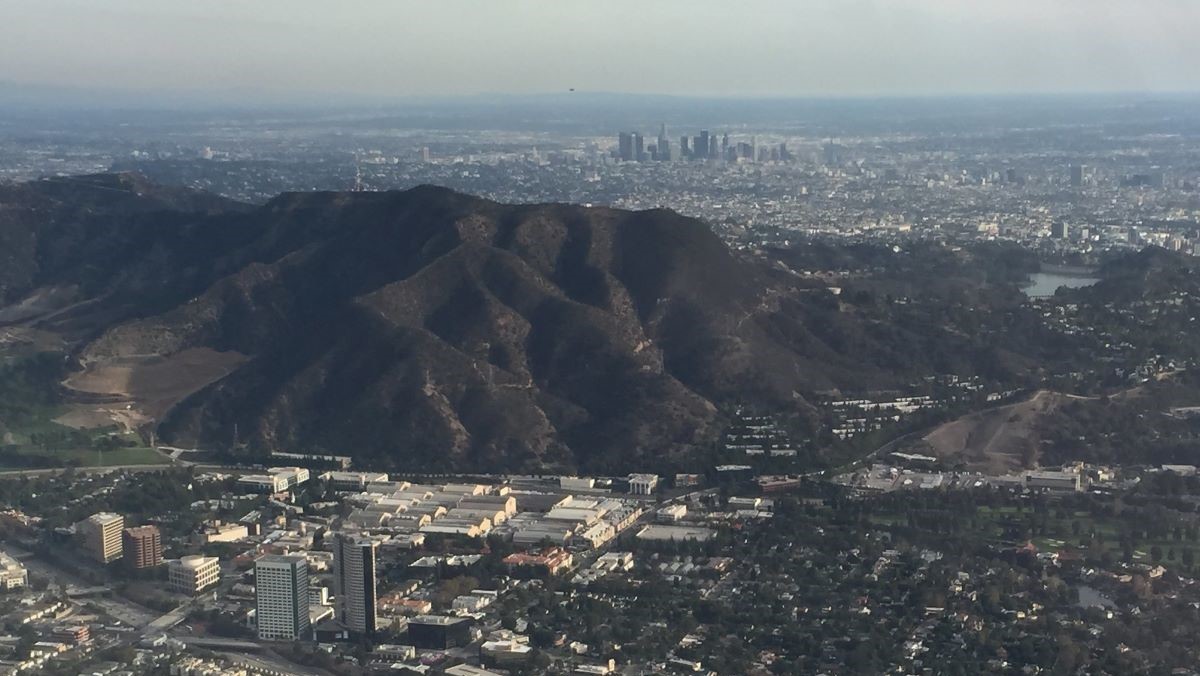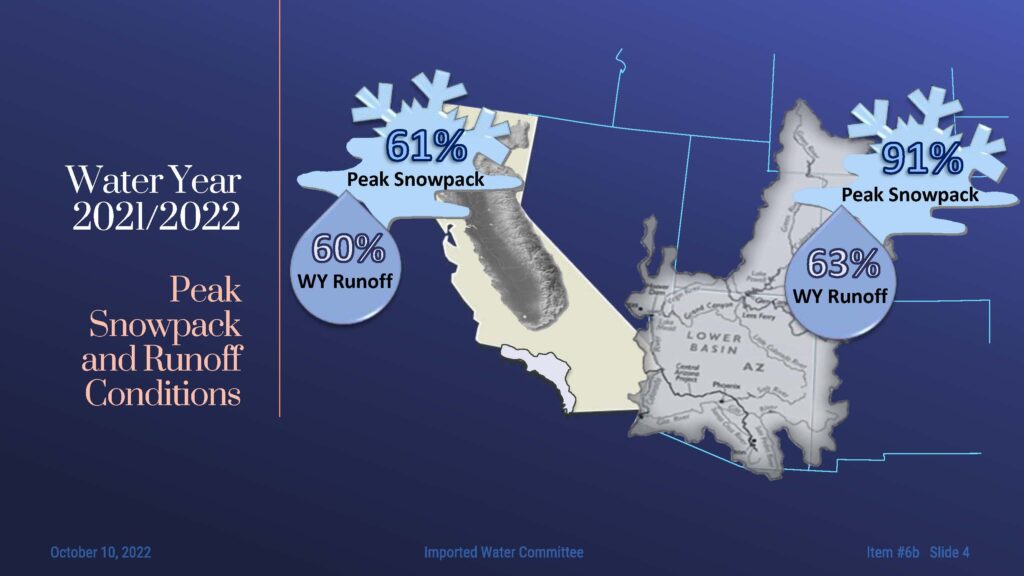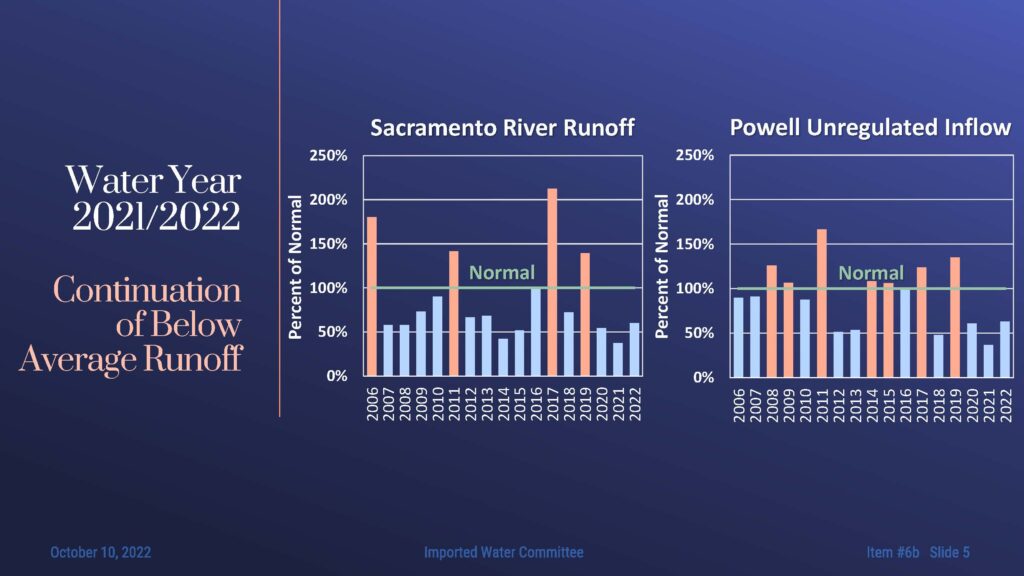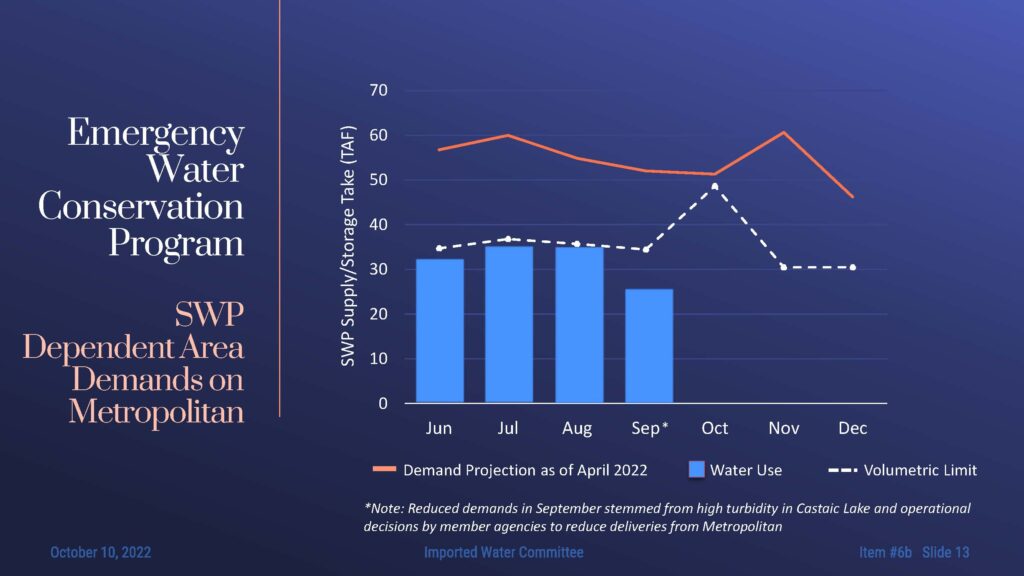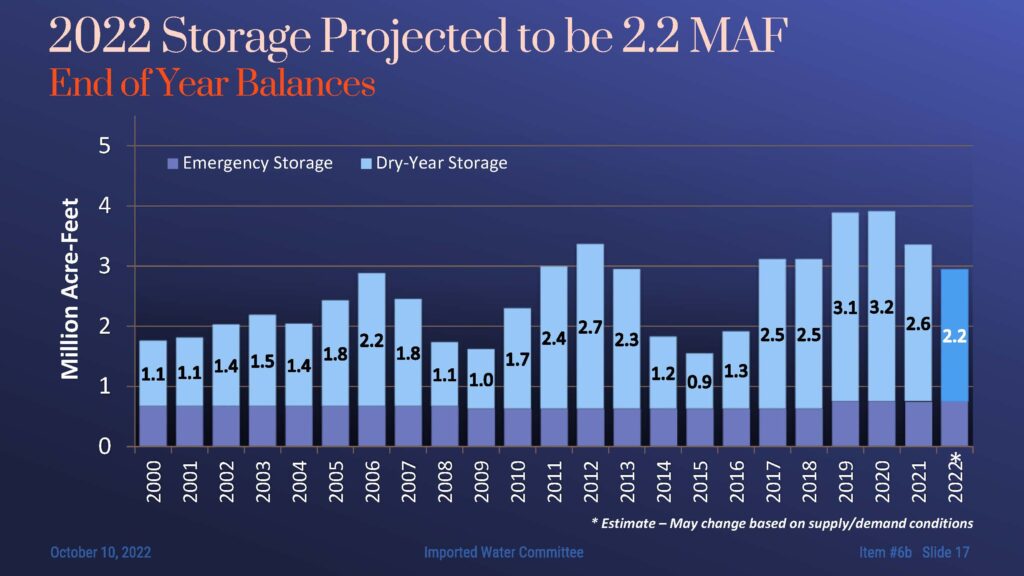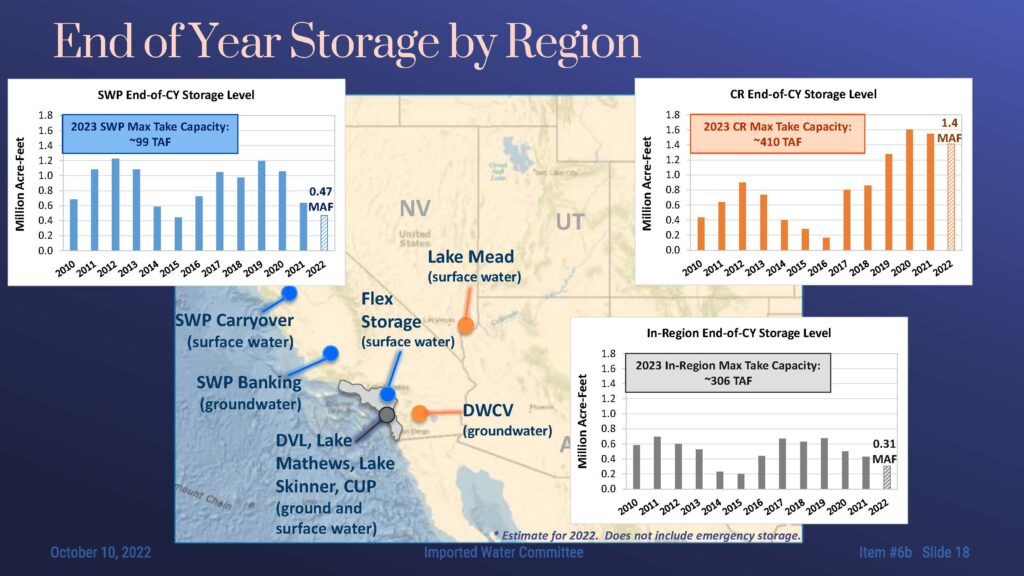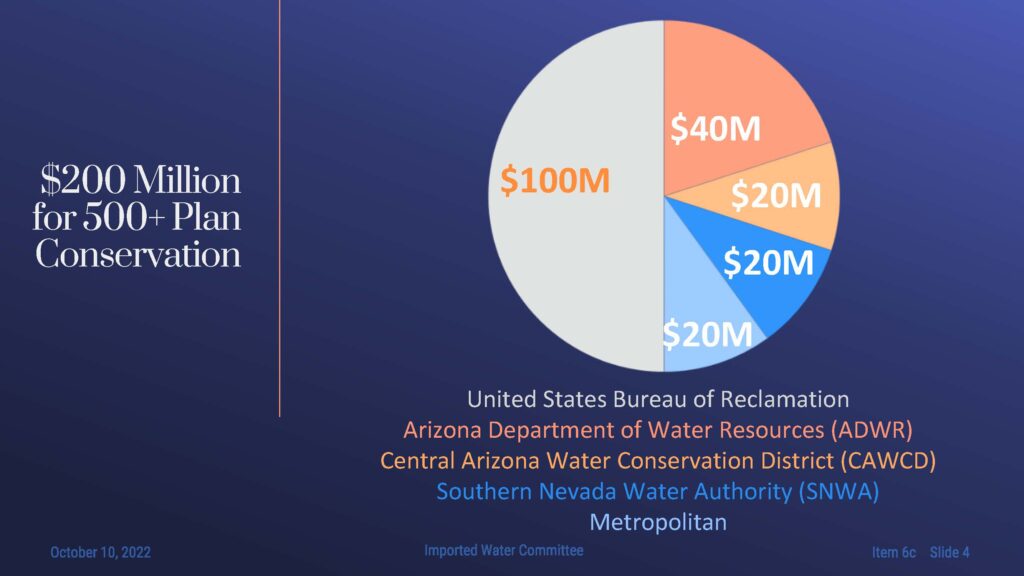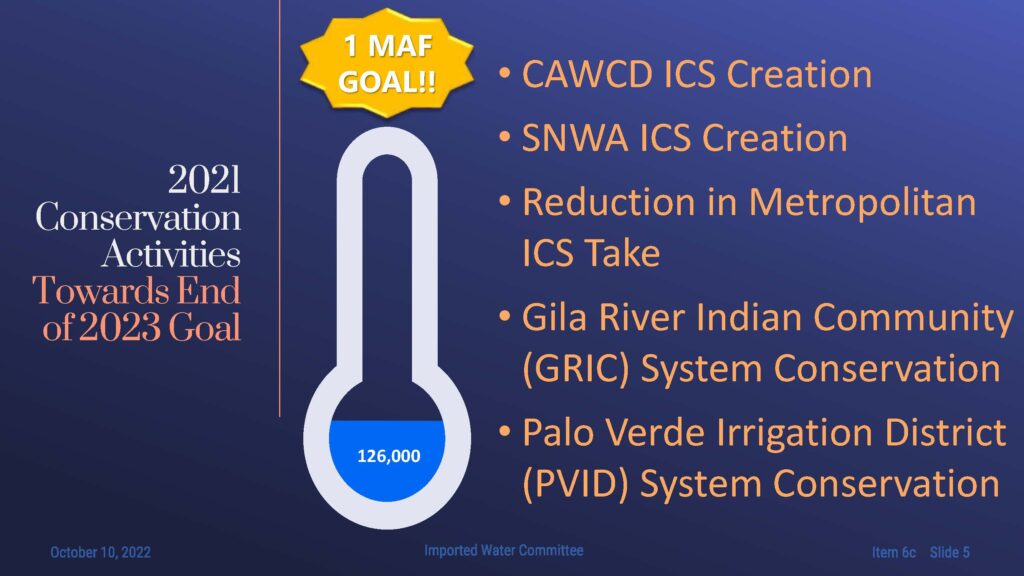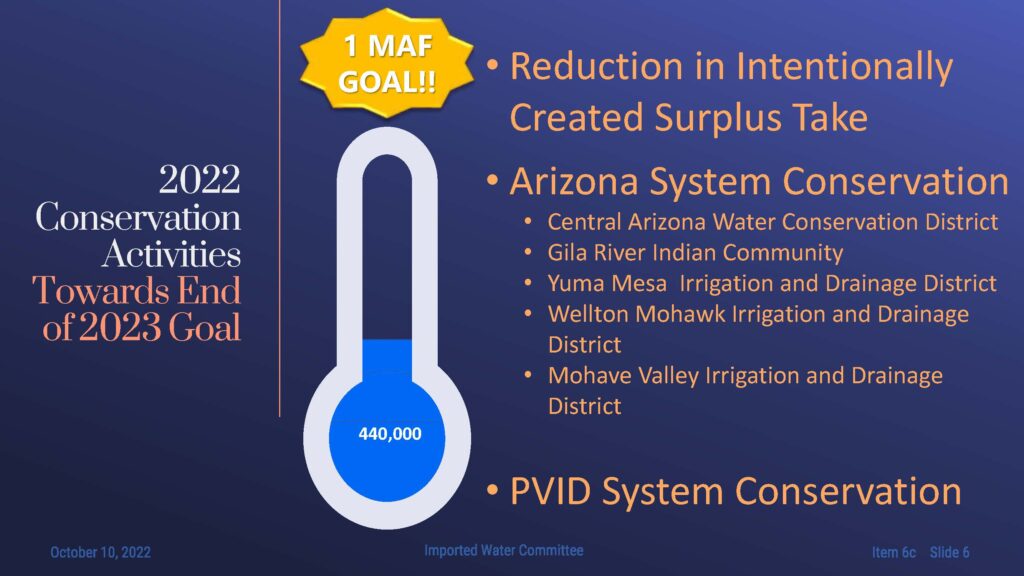At the October meeting of Metropolitan’s Imported Water Committee, staff briefed committee members on available supplies and water demands, the Emergency Water Conservation Program for State Water Project-dependent areas, and the efforts to address the extreme drought conditions in the Colorado River Basin.
Main takeaways from the presentations:
- After three dry years, Metropolitan’s supplies are stretched thin;
- Stored water supplies are not evenly distributed throughout the region, and there are constraints on accessing some of those supplies;
- If the State Water Project allocation is 20% or lower, State Water Project-dependent areas won’t see any relief next year; and
- As California agencies and other basin states work to leave water in the Colorado River, more restrictions are likely for the Metropolitan’s areas that are dependent on the Colorado River.
Water supply and demand balance
Noosha Razavian, Associate Resource Specialist, provided an update on Metropolitan’s current water supply and demand balance. With the water year just recently ended, Ms. Razavian began by briefly recapping the 2021-2022 water year.
There was a fair amount of snowpack in both the State Water Project and the Colorado River Basin. However, while the peak snowpack in the Colorado River Basin increased slightly compared to last year, the peak snowpack in the Sacramento River Basin dropped by around 11% compared to last year.
She also pointed out that, unlike previous years, snowfall in the Sacramento River Basin peaked in January, which was quite early. The hot and dry conditions affected both regions, leading to a low amount of runoff, as it has been in the past few years.
The graphs on the slide below show the average runoff for the Sacramento River and the unregulated inflows for Lake Powell. The light blue bars depict the predominantly below-average runoff for both watersheds.
“While the Sacramento River runoff was the 25th driest year on record, Lake Powell unregulated inflows were the twelfth driest,” said Ms. Razavian. “However, when coupled with the previous water year, the runoff from Sacramento and Lake Powell was the fourth and third driest two-year periods on record, respectively.”
The current supply estimate is approximately 1.28 million acre-feet, which includes the current Colorado River Aqueduct estimate adjusted for the higher priority water use, the 5% State Water Project Table A allocation, 134,000 acre-feet of human health and safety supplies, and the latest estimate for transfer supplies.
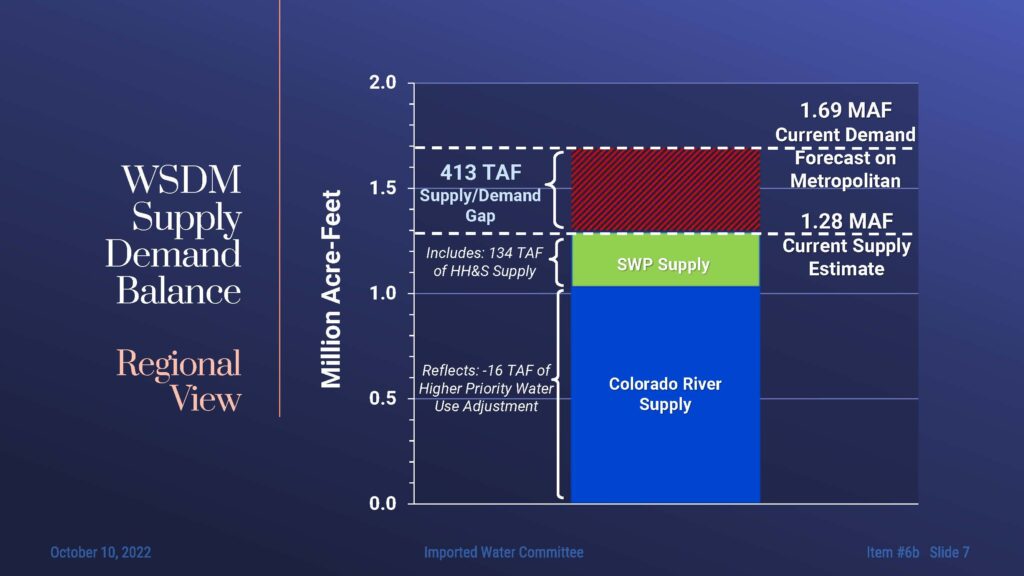 Ms. Razavian noted that the current higher priority water use adjustment on the Colorado River has shifted from negative 63,000 acre-feet last month to negative 16,000 acre-feet this month.
Ms. Razavian noted that the current higher priority water use adjustment on the Colorado River has shifted from negative 63,000 acre-feet last month to negative 16,000 acre-feet this month.
As for demand, the current demand is projected to be around 1.69 million acre-feet, and since supply is less than demand, this leaves a gap of about 413,000 acre-feet. Storage withdrawals, water purchases, and conservation efforts across the region are helping to satisfy the supply and demand gap.
Emergency water conservation program
Four months have passed since the program’s inception on June 1 of this year. During September, three member agencies continued under path one while the remaining agencies continued under path two. Additionally, no penalties have been issued for any path two agencies thus far in the program, and path one compliance requirements remain at one day week watering through November.
The chart below shows the water use within the State Water Project dependent area. June through September demands fell below the projected demand and the volumetric limits for each of those respective months. She noted that a portion of the reduced demands in September stemmed from high turbidity in Castaic Lake and operational decisions by the city of Los Angeles to reduce deliveries from Metropolitan and rely more on local supplies during this time.
Additionally, the volumetric limits for October through December have shifted slightly, largely due to Upper San Gabriel taking their full 2022 allocated amount of state supplies in October.
As of September 30, the State Water Project dependent area has used around 130,000 acre-feet of water and is currently trending about 8% below the total 2022 volumetric limit.
The one decision remaining in the year is a total ban on outdoor watering for Path One agencies in December. If the staff decides this is necessary, they will inform the affected agencies with at least 30 days prior notice and report to the board on this decision next month.
Planning for a dry 2023
Metropolitan staff project ending the calendar year with approximately 2.2 million acre-feet of region-wide dry year storage. While at first glance, it appears that there are plenty of reserves for the next year, the storage is not evenly distributed across State Water Project, Colorado River, and in-region assets.
Over half of Metropolitan’s dry-year storage supplies will be in the Colorado River supplies next year. However, much of the storage in Lake Mead will need to be held back to satisfy DCP contributions and obligations in the coming years. For those and other reasons, not all of the projected 2.2 million acre-feet of storage will be accessible to Metropolitan in 2023.
“If we assume a 5% State Water Project allocation for 2023, the maximum take capacities for each of the three regions put real-world constraints on the storage available for Metropolitan to draw upon,” said Ms. Razavian. “Declining storage supplies, as well as maximum take capacities and operational limitations, have significant impacts on our planning for this next year.”
She said there are three major water supply problems facing Metropolitan next year:
- An acute shortage of State Water Project supplies to meet the demands of the State Water Project-dependent areas will continue to persist into 2023, largely due to an expected low initial State Water Project Table A allocation, already depleted State Water Project storage supplies, and already limited take capacities.
- The Colorado River Basin’s recently declared level 2A shortage for next year has reminded everyone of the dire conditions faced in the lower basin. Much of Lake Mead’s storage will need to be held back to satisfy future DCP contributions.
- In-regional storage accounts have dwindled these past few years, thus precluding any additional supplies available to Metropolitan.
There are three potential allocation methods available:
- The emergency water conservation program, currently approved through June 30, 2023
- The water supply allocation plan
- Another potential allocation method, which staff would bring to the board if another possible approach were under consideration.
Next year’s State Water Project allocation will have an immense impact on our operations and planning throughout the year, said Ms. Razavian. “Under a low 2023 State Water Project allocation of around 20% or lower, we’ll likely extend the length of the emergency water conservation program within the dependent area beyond June 30. And a low allocation also puts pressure on our already limited Colorado River supplies while also having to deplete our regional storage.”
“However, with a high State Water Project allocation of around 60% or more, we’ll be able to meet our demands within the dependent area and provide more of an opportunity to replenish the storage that serves that area, as well as repay the human health and safety obligations already incurred. Once those obligations have been met, we can deliver to the State Water Project areas, and reduce some of the pressure off of our Colorado River supplies.”
Next steps:
- Metropolitan staff continues to evaluate each member agency’s past compliance and any potential penalties incurred by the member agencies for the emergency water conservation program, as well as provide the monitoring reports weekly.
- Staff will continue to work with the member agencies to determine the appropriate parameters for the emergency water conservation program, and any potential region-wide allocation program approaches for the next year.
- Staff will continue to coordinate with member agencies on any impacts from any system limitations within the service area.
Update on the Colorado River 500 Plus Plan
Laura Lamdin, an engineer in water resource management, provided an update on the 500-Plus Plan and efforts to protect Lake Mead.
In December 2021, the Metropolitan Board approved participation in the 500-Plus Plan. The Plan was then signed at the Colorado River Water Users Association Conference that same week. Signatories included USBR, Metropolitan, the Arizona Department of Water Resources, the Central Arizona Water Conservation District, the Colorado River Commission of Nevada, and the Southern Nevada Water Authority.
The 500-Plus Plan is a Memorandum of Understanding between Reclamation and parties in the Lower Basin that set a target of adding 500,000 acre-feet to Lake Mead in calendar years 2022 and 2023, as well as funding for reaching that target.
Water counts toward the 500 Plus Plan if additional water remaining in Lake Mead is not attributable to 2007 guidelines shortage cuts or drought contingency plan contributions. More specifically, water counts toward the Plan if, when compared to a baseline of Reclamation’s June 2021 24 months study’s most probable projection, there is additional ICS creation or a reduction in ICS takes.
New system conservation or efficiency projects are the only projects for 500 Plus Plan funding, as the water is conserved and left in Lake Mead for the benefit of the system, as opposed to ICS, where it accrues to a particular user. There is $200 million available for these two categories of water, with Metropolitan contributing $20 million to the pot.
In 2021, actions that contributed to the 500 Plus Plan: Palo Verde Irrigation District system conservation, Gila River Indian Community system conservation, a reduction in Metropolitan’s ICS take, and additional ICS creation by the Southern Nevada Water Authority and the Central Arizona Water Conservation District that collectively generated 126,000 acre-feet.
Conservation for the 500 Plus Plan continued in 2022, as the PVID system conservation program was fully implemented, and new system conservation agreements were signed in Arizona with CAP contractors, the Gila River Indian Community, and three different irrigation and drainage districts. And as of now, both Arizona and Metropolitan have planned a reduction in ICS take when compared with the baseline.
“If these forecasts hold by the end of the year, the group will have collectively added about 440,000 acre-feet to the 500 Plus plan,” said Ms. Lamdin.
However, in the middle of implementing the 500 Plus Plan, the need for even more conservation became more evident when USBR Commissioner Touton made a statement at the June Senate hearing of the Senate committee of Energy and Natural Resources that an additional two to 4 million acre-feet of annual conservation is needed to protect critical elevations at Lake Powell and Mead.
Implementation of the 500 Plus Plan has morphed into efforts to come up with a plan to meet the commissioner’s call for increased conservation, and it is now the focus of ongoing efforts to protect Lake Mead. To help fund the increased water conservation goals, $4 billion was included in the 2022 inflation Reduction Act for tackling drought in the Colorado River Basin and across the American West. This is in addition to the funding in the pie chart shown earlier.
“We are figuring out how the Inflation Reduction Act funds and the call for increased conservation will come together,” said Ms. Lamdin. “But we anticipate new programs will be developed to match the funding and conservation opportunities. In California, programs are being explored with PVID, Coachella, and IID. Overall, the situation is still very fluid. So our next steps will be to continue working to figure out how the IRA funding and the increased conservation will come together. And then continue to report back to this committee as those conversations evolve.”
Update on Colorado River Basin conditions
Bill Hasencamp, Manager of Colorado River Resources, began with some good news. “It’s been a summer to remember in the Colorado basin as far as rainfall,” he said. “From San Jacinto to Santa Fe, from Tucson to Telluride, the summer rains have pounded the desert for four months and brought significant precipitation in the basin. In fact, Lake Powell is now four feet higher than it was projected to be on this date back in June. And Lake Mead is eight feet higher than it was projected to be just four months ago. So we have 12 feet of extra water in Lake Powell and Lake Mead that we didn’t think we’d have at the beginning of summer, thanks to those beneficial rains.”
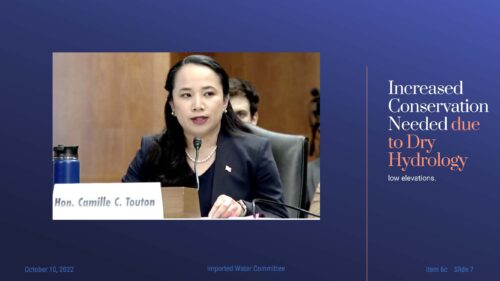 Last week, California agencies signed a letter proposing to conserve 400,000 acre-feet of additional water per year from 2023 to 2026. He noted that it was supposed to be a lower basin or seven-state plan, but so far, it’s just a California letter. After Commissioner Touton’s call for an additional 2-4 MAF per year, Metropolitan worked hard with the partners on the river, but just couldn’t get a plan completed by August. When the August deadline was reached without a deal, Reclamation responded that a lot of progress had been made, and they would continue working with the states. Funding had been secured through the inflation Reduction Act to help assist that Plan.
Last week, California agencies signed a letter proposing to conserve 400,000 acre-feet of additional water per year from 2023 to 2026. He noted that it was supposed to be a lower basin or seven-state plan, but so far, it’s just a California letter. After Commissioner Touton’s call for an additional 2-4 MAF per year, Metropolitan worked hard with the partners on the river, but just couldn’t get a plan completed by August. When the August deadline was reached without a deal, Reclamation responded that a lot of progress had been made, and they would continue working with the states. Funding had been secured through the inflation Reduction Act to help assist that Plan.
“Some of the other states, however, started a different path and started to pick on California, saying, ‘we’re taking shortages, California is taking ICS,’ and suggesting that it’s time for the federal government to take evaporation losses and apply it throughout the basin as early as next year,” said Mr. Hasencamp.
“The California agencies got together and said, ‘we realize there are some big issues that we have to solve as a basin and including the structural deficit, including a lot of other issues. The place to resolve those issues is the development of the guidelines, not quickly developed in this process.’ So California said, we will go ahead and take the lead on developing a plan to conserve water for next year, which is 400,000 acre-feet of new agricultural conservation on top of the DCP commitment we already have. And if Lake Mead drops to where it’s forecast to be by 2024, we will be giving 350,000 acre-feet of DCP contributions on top of 400,000 acre-feet of new reductions. So 750,000 acre-feet of reductions, California is proposing if Lake Mead goes down, and we have to make those reductions.”
Mr. Hasencamp acknowledged that it’s a significant reduction being proposed, and it’s subject to sufficient federal funding and CEQA compliance. “But if we can get those things, then we are prepared to move forward with this Plan. It will take a lot of work. … implementing reductions of this size will take time to develop the agreements. We don’t have a lot of time. So we’re in full-speed mode to get something done in the next few months, or maybe early 2023, to come back to your board for consideration.”
Metropolitan staff report on water supply and demand
10112022 IW 6b Report

